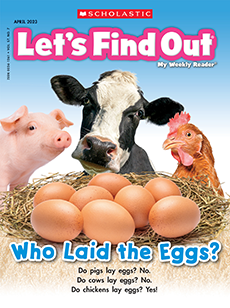A guide for using our resources
Children will examine the properties of bubbles.
Vocabulary: burst, film, iridescent, sphere
Science Focus: properties of matter
Simple, spectacular ideas to boost your lessons.
Paired Text: Big Bad Bubble by Adam Rubin
Paired Text: Big Bad Bubble by Adam Rubin
- In another hilarious book by the author of Dragons Love Tacos, the big bad monsters are afraid of tiny harmless bubbles! Can kids help talk them out of their fears?
Mini-Experiment: Test Bubble Shapes
Mini-Experiment: Test Bubble Shapes
- Are bubbles always round? Test it out! Help kids shape bubble wands from pipe cleaners. In addition to a round wand, make a square wand, a triangular wand, or any other shape you like.
- Use your wands with bubble solution (to make your own, see the hands-on activity below). Before kids blow their bubbles from each wand, have them predict what shape the bubbles will be. They will see that no matter what shape the wand is, the bubbles are always round!
Scavenger Hunt: Pages 2-3
Scavenger Hunt: Pages 2-3
- Use pages 2-3 of the issue to do this scavenger hunt as a group.
- Find the picture with a stretched-out bubble. Put a ✓on it.
- In the purple box, find the wordthat means “break apart.” Circle it.
- Find the heading. Underline it.
- Look at the bottom bar. Circle the word iridescent each time it appears.
Hands-on Activity: Make Your Own Bubble Solution
Hands-on Activity: Make Your Own Bubble Solution
Skill: making observations
Materials: empty two-liter bottle, dish soap, corn syrup, bubble wands
- Kids can learn a whole lot of science while making their own bubbleblowing solution!
- Fill the bottle three-quarters of the way with water and then add a halfcup of dish soap. Test the solution by trying to blow bubbles with it. (It won’t work.) Discuss why it’s not working—the soapy water isn’t thick enough. It’s not strong enough to wrap itself around the air without breaking.
- Now pour a half-cup of corn syrup into the mixture, pointing out that the syrup is thicker than water. Let the syrup dissolve. (You can close the bottle and shake it, or let it sit in the sun for a while.)
- Test the solution again. Now children can blow bubbles! That’s because the corn syrup helped increase the surface tension of each bubble, making it strong enough to hold the air inside.
